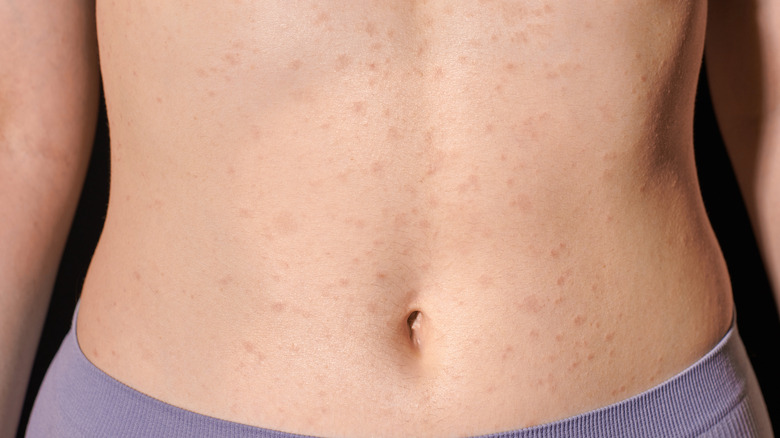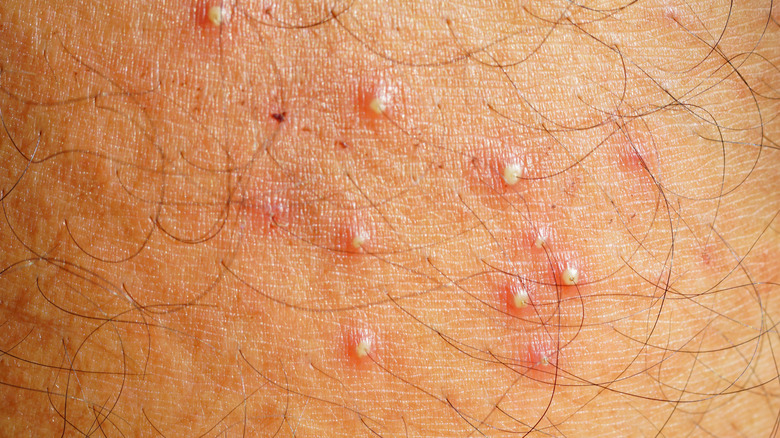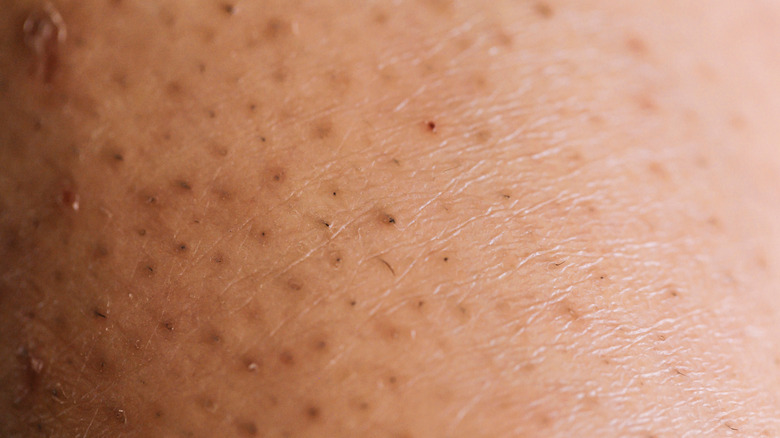The Acne On Your Stomach Could Be Something Else
Despite being one of the most common skin conditions (via the American Academy of Dermatology), finding out all you need to know about acne — including treatments and remedies — can be overwhelming. Particularly when you consider that it can occur anywhere on the body and not just your face.
Acne occurs when the pores of your skin become blocked with debris like oil, dirt, bacteria, or dead skin cells. A pore is the opening to a hair follicle that sits underneath layers of skin (via The Dermatology Specialists), which is why some spots and pimples can feel so painfully deep. As the Mayo Clinic suggests, pimples usually occur on areas of the skin where these pores are susceptible to sebaceous glands, which can produce excess amounts of oil that block follicles and pores leading to acne.
You'll usually find acne on the face, neck, back, and chest. So why can pimples be found in other places like the stomach? Well, it may be because these spots are something else entirely.
You could be dealing with a bacterial infection
Unlike the spots you typically find on your face, back, or chest, stomach acne isn't always the result of a blocked pore or hair follicle. Instead, Medical News Today suggests that ingrown hair or folliculitis are the main culprits for what may look like stomach acne.
If you're experiencing a breakout of inflamed spots, you may be dealing with folliculitis, a common skin condition brought on by a "bacterial or fungal infection." According to Healthline, folliculitis may present as a collection of spots, a rash, or a "large, single bump" that can last for a few days or become a chronic condition. Staphylococcus aureus is usually the culprit of folliculitis, as this bacteria is always on the skin. An infection occurs once the skin is broken and the bacteria enters a hair follicle which presents itself in an acne-like rash (via the American Academy of Dermatology).
Like Staphylococcus aureus, the yeast Pitysporum is always on the skin, but it can overgrow when triggered by stress, high temperatures, trapped moisture, and greasy skin products. You can also get folliculitis from spending too much time in a hot tub if the bacteria Pseudomonas aeruginosa is present (via the Centers for Disease Control).
It's always best to see your doctor if you have symptoms of folliculitis, as they can prescribe hydrocortisone or antibiotic ointment to treat whichever bacteria may have infected your skin.
Ingrown hair has similar qualities to a pimple breakout
Ingrown hair can also present itself like acne. People with curly or coarse hair are more prone to this skin condition (via Healthline) due to how ingrown hair curls itself back into the skin once it starts to grow back after being removed by shaving or friction from clothes (via Mayo Clinic). The process of hair becoming ingrown can cause painful red bumps, sometimes referred to as razor bumps (via Medical News Today). These commonly occur when you shave too close to the skin.
Shaving too close to the skin or against the direction of growth, otherwise known as "against the grain" (via Gillette), can cause hair to grow back with a sharper edge, making it easier for the hair to curl and pierce itself back into the skin as it grows back. When this happens, "your skin reacts as it would to a foreign body" and "becomes irritated," as Mayo Clinic notes. To treat and prevent ingrown hair, Healthline suggests cleaning the area with warm, soapy water twice a day, followed by an antibiotic ointment to help treat the swelling.


